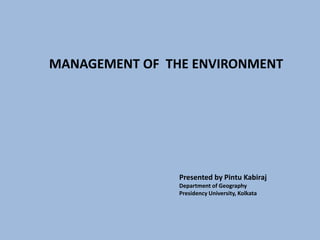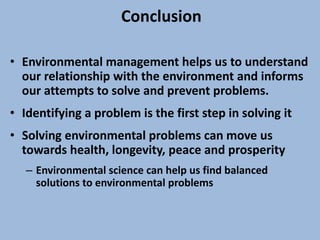MANAGEMENT OF THE ENVIRONMENT
- 1. MANAGEMENT OF THE ENVIRONMENT Presented by Pintu Kabiraj Department of Geography Presidency University, Kolkata
- 2. This article will help to understand : 1) What is environment ? 1) What is Environmental Management ? 2) Why Environmental Management ? 3) What is environmental Management System 4) Scope of Environmental Management 5) Approaches of Environmental Management 6) Principles of Environmental Management
- 3. • All the things around us with which we interact: • Living things • Animals, plants, forests, fungi, etc. • Nonliving things • Continents, oceans, clouds, soil, rocks • Our built environment • Buildings, human-created living centers • Social relationships and institutions Environment: the total of our surroundings
- 4. What is Environmental Management..? Environmental management is a mixture of science, policy, and socioeconomic applications. 1) It focuses on the solution of the practical problems that humans encounter in cohabitation with nature, exploitation of resources, and production of waste. 2) In a purely anthropocentric sense, the central problem is how to permit technology to evolve continuously while limiting the degree to which this process alters natural ecosystem. 3) Environmental management is thus intimately intertwined with questions regarding economic growth, equitable distribution of consumable goods, and conserving resources for future generations.
- 5. Why Environmental management? • Humans change the environment, often in ways not fully understood • We depend completely on the environment for survival – Increased wealth, health, mobility, leisure time – But, natural systems have been degraded • i.e., pollution, erosion and species extinction – Environmental changes threaten long-term health and survival And Environmental Management is the study of: – How the natural world works – How these problems can be solved associated with the environmental degradation?
- 6. Environmental management … can help us avoid mistakes made by past civilizations. The lesson of Easter Island: people annihilated their culture by destroying their environment. Can we act more wisely to conserve our resources?
- 7. We face challenges in agriculture • Expanded food production led to increased population and consumption • It’s one of humanity’s greatest achievements, but at an enormous environmental cost • Nearly half of the planet’s land surface is used for agriculture • Chemical fertilizers • Pesticides • Erosion • Changed natural systems
- 8. We face challenges in pollution • Waste products and artificial chemicals used in farms, industries, and households Each year, millions of people die from pollution
- 9. We face challenges in climate • Scientists have firmly concluded that humans are changing the composition of the atmosphere • The Earth’s surface is warming • Melting glaciers • Rising sea levels • Impacted wildlife and crops • Increasingly destructive weather Since the Industrial Revolution, atmospheric carbon dioxide concentrations have risen by 37%, to the highest level in 650,000 years
- 10. We face challenges in biodiversity •Human actions have driven many species extinct, and biodiversity is declining dramatically • We are at the onset of a mass extinction event Biodiversity loss may be our biggest environmental problem; once a species is extinct, it is gone forever
- 11. What is Environmental Management System Environmental management system (EMS) refers to the management of an organization's environmental programs in a comprehensive, systematic, planned and documented manner. It includes the organizational structure, planning and resources for developing, implementing and maintaining policy for environmental protection. More formally, EMS is "a system and database which integrates procedures and processes for training of personnel, monitoring, summarizing, and reporting of specialized environmental performance information to internal and external stakeholders of a firm.“ EMS is typically reported using International Organization of Standards (ISO) 14001 to help understand the EMS process.
- 12. Scope of Environmental Management Environmental resource management can be viewed from a variety of perspectives. 1) Environmental resource management involves the management of all components of the biophysical environment, both living (biotic) and non- living (a biotic). 2) This is due to the interconnected and network of relationships amongst all living species and their habitats. The environment also involves the relationships of the human environment, such as the social, cultural and economic environment with the biophysical environment. 3) The essential aspects of environmental resource management are ethical, economical, social, and technological. These underlie principles and help make decisions.
- 13. Principles of Environmental Management There are five guiding principles for incorporating environmental concerns in to decision making. These principles can be used to design environmental instruments and to raise funds to finance environmental public investments plans in the spectral and overall budget. They are, 1. Polluter pays principle (PPP) 2. User pays principle (UPP) (or resource pricing principle). 3. Precautionary principle (PP). 4. Subsidiary principle (SP) 5. Intergenerational equity principle (IEP
- 14. 1) Polluter pays principle The Polluter Pays Principle was first widely discussed in the United Nations Conference on Environment and Development held in Rio de Janeiro of Brazil in June 1992. This principle was endorsed by all the attending representatives of the countries The PPP required that the polluter has to bear the cost of complying with environmental standards, which are predetermined by public authorities. If the polluters have to pay for the cost of any pollution they cause, 2) User pays principle The UPP states that the beneficiaries should pay for the full cost of using the resources and its related service; the full cost included the cost of losses for future generations. Both PPP and UPP principle considered as equitable and both offer the prospect of achieving efficiency.
- 15. 3) precautionary principle The Precautionary Principle was adopted by the UN Conference on Environment and Development (the Earth Summit) in 1992. According to Rio Declaration on Environment and Development Precautionary Principle as meaning that where there are threats of serious or irreversible damage to environment, lack of scientific certainty should not be used as s to environment for postponing cost effective measures to prevent environmental degradation. 4) Subsidiary principle Subsidiary principle (SP), was not designed for as an environmental principle, but it provides useful guidance when applying the PPP and UPP and the PP. SP states that political decisions should be taken by lowest possible level of public authority dependence with effective action.
- 16. 5) Intergenerational equity principle The IEP is the central principle in the definition of sustainable development. According to the Brundtland Report sustainability states that‘s meeting needs of present generations without compromising the needs of future generations’. Generally this principle is considered with the trilogy of economic, environmental and social objectives underlying sustainable development. This principle is the basis of the environmental accounting measures of sustainable income. All the above five environmental management principles will be used to guide the sectoral policies and budgeting process.
- 17. Conclusion • Environmental management helps us to understand our relationship with the environment and informs our attempts to solve and prevent problems. • Identifying a problem is the first step in solving it • Solving environmental problems can move us towards health, longevity, peace and prosperity – Environmental science can help us find balanced solutions to environmental problems
- 18. Thank you

















